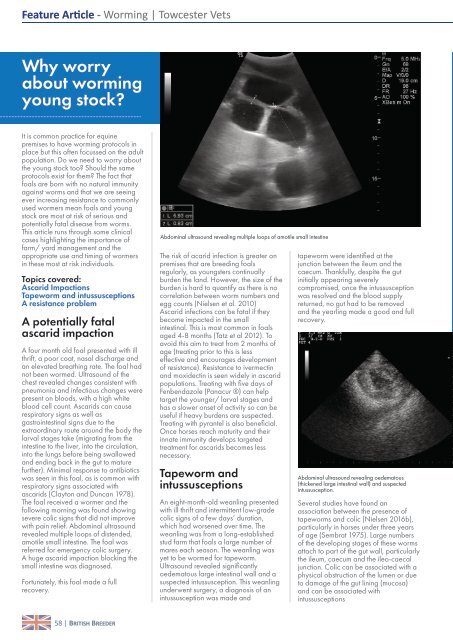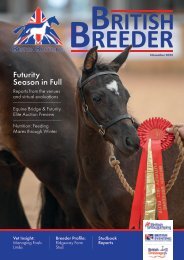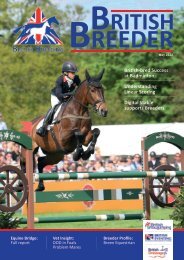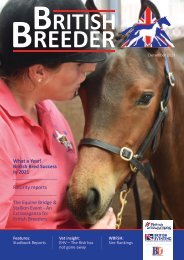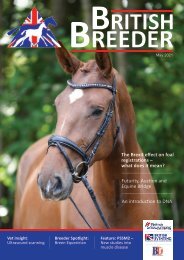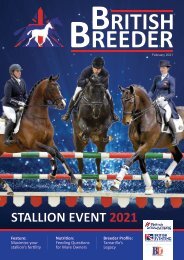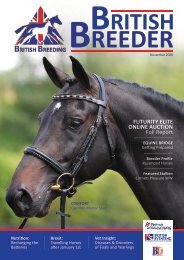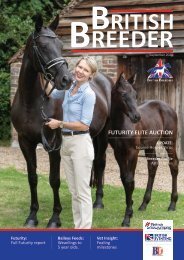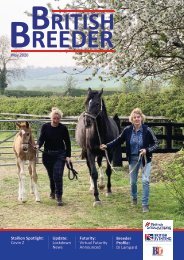British Breeder February 2022
British Breeder magazine is a must have for mare and stallion owners in the UK and for riders who love producing young horses. The much anticipated February edition profiles each stallion that was showcased at the Stallion Event, as well as featuring the British Breeding Futurity Awards and Equine Bridge all previewed ahead of the big event. Veterinary insights cover Ovum Pickup and Equine Viral Arteritis, whilst the Producer profile features Elite Dressage.
British Breeder magazine is a must have for mare and stallion owners in the UK and for riders who love producing young horses. The much anticipated February edition profiles each stallion that was showcased at the Stallion Event, as well as featuring the British Breeding Futurity Awards and Equine Bridge all previewed ahead of the big event. Veterinary insights cover Ovum Pickup and Equine Viral Arteritis, whilst the Producer profile features Elite Dressage.
Create successful ePaper yourself
Turn your PDF publications into a flip-book with our unique Google optimized e-Paper software.
Feature Article - Worming | Towcester Vets<br />
Why worry<br />
about worming<br />
young stock?<br />
It is common practice for equine<br />
premises to have worming protocols in<br />
place but this often focussed on the adult<br />
population. Do we need to worry about<br />
the young stock too? Should the same<br />
protocols exist for them? The fact that<br />
foals are born with no natural immunity<br />
against worms and that we are seeing<br />
ever increasing resistance to commonly<br />
used wormers mean foals and young<br />
stock are most at risk of serious and<br />
potentially fatal disease from worms.<br />
This article runs through some clinical<br />
cases highlighting the importance of<br />
farm/ yard management and the<br />
appropriate use and timing of wormers<br />
in these most at risk individuals.<br />
Topics covered:<br />
Ascarid Impactions<br />
Tapeworm and intussusceptions<br />
A resistance problem<br />
A potentially fatal<br />
ascarid impaction<br />
A four month old foal presented with ill<br />
thrift, a poor coat, nasal discharge and<br />
an elevated breathing rate. The foal had<br />
not been wormed. Ultrasound of the<br />
chest revealed changes consistent with<br />
pneumonia and infectious changes were<br />
present on bloods, with a high white<br />
blood cell count. Ascarids can cause<br />
respiratory signs as well as<br />
gastrointestinal signs due to the<br />
extraordinary route around the body the<br />
larval stages take (migrating from the<br />
intestine to the liver, into the circulation,<br />
into the lungs before being swallowed<br />
and ending back in the gut to mature<br />
further). Minimal response to antibiotics<br />
was seen in this foal, as is common with<br />
respiratory signs associated with<br />
ascarids (Clayton and Duncan 1978).<br />
The foal received a wormer and the<br />
following morning was found showing<br />
severe colic signs that did not improve<br />
with pain relief. Abdominal ultrasound<br />
revealed multiple loops of distended,<br />
amotile small intestine. The foal was<br />
referred for emergency colic surgery.<br />
A huge ascarid impaction blocking the<br />
small intestine was diagnosed.<br />
Fortunately, this foal made a full<br />
recovery.<br />
Abdominal ultrasound revealing multiple loops of amotile small intestine<br />
The risk of acarid infection is greater on<br />
premises that are breeding foals<br />
regularly, as youngsters continually<br />
burden the land. However, the size of the<br />
burden is hard to quantify as there is no<br />
correlation between worm numbers and<br />
egg counts (Nielsen et al. 2010)<br />
Ascarid infections can be fatal if they<br />
become impacted in the small<br />
intestinal. This is most common in foals<br />
aged 4-8 months (Tatz et al 2012). To<br />
avoid this aim to treat from 2 months of<br />
age (treating prior to this is less<br />
effective and encourages development<br />
of resistance). Resistance to ivermectin<br />
and moxidectin is seen widely in ascarid<br />
populations. Treating with five days of<br />
Fenbendazole (Panacur ®) can help<br />
target the younger/ larval stages and<br />
has a slower onset of activity so can be<br />
useful if heavy burdens are suspected.<br />
Treating with pyrantel is also beneficial.<br />
Once horses reach maturity and their<br />
innate immunity develops targeted<br />
treatment for ascarids becomes less<br />
necessary.<br />
Tapeworm and<br />
intussusceptions<br />
An eight-month-old weanling presented<br />
with ill thrift and intermittent low-grade<br />
colic signs of a few days’ duration,<br />
which had worsened over time. The<br />
weanling was from a long-established<br />
stud farm that foals a large number of<br />
mares each season. The weanling was<br />
yet to be wormed for tapeworm.<br />
Ultrasound revealed significantly<br />
oedematous large intestinal wall and a<br />
suspected intussusception. This weanling<br />
underwent surgery, a diagnosis of an<br />
intussusception was made and<br />
tapeworm were identified at the<br />
junction between the ileum and the<br />
caecum. Thankfully, despite the gut<br />
initially appearing severely<br />
compromised, once the intussusception<br />
was resolved and the blood supply<br />
returned, no gut had to be removed<br />
and the yearling made a good and full<br />
recovery.<br />
Abdominal ultrasound revealing oedematous<br />
(thickened large intestinal wall) and suspected<br />
intussusception.<br />
Several studies have found an<br />
association between the presence of<br />
tapeworms and colic (Nielsen 2016b),<br />
particularly in horses under three years<br />
of age (Sembrat 1975). Large numbers<br />
of the developing stages of these worms<br />
attach to part of the gut wall, particularly<br />
the ileum, caecum and the ileo-caecal<br />
junction. Colic can be associated with a<br />
physical obstruction of the lumen or due<br />
to damage of the gut lining (mucosa)<br />
and can be associated with<br />
intussusceptions<br />
58 | BRITISH BREEDER


